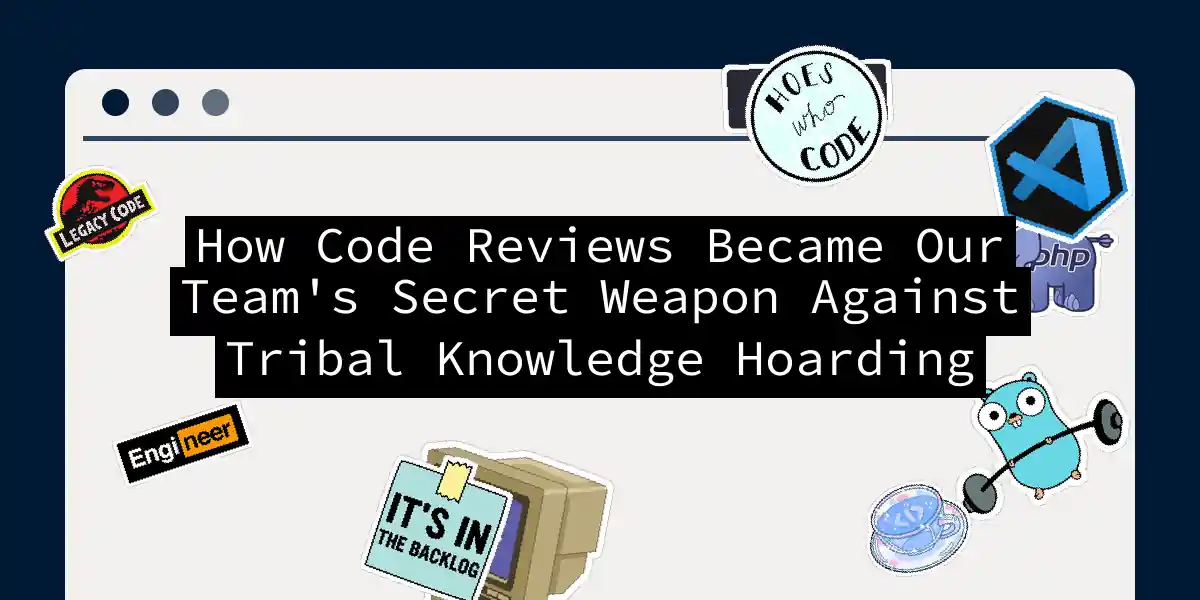Picture this: You’re staring at a Python script that somehow uses walrus operators to parse XML while simultaneously brewing coffee. The original author? They’ve just boarded a one-way flight to Mars Colony One. This is why we don’t let junior devs write code after 3 espresso shots… and why code reviews are my team’s equivalent of a cryptographic checksum for knowledge preservation.
From Merge Conflicts to Mind Melds
Early in my career, I thought code reviews were just glorified spell checks for code. Then I inherited a legacy system where the documentation consisted of a Post-It note saying “Here be dragons.” The turning point came when we formalized our review process using what I call the 3X Framework:
- eXamine (technical correctness)
- eXchange (knowledge transfer)
- eXpand (document tribal knowledge) Here’s how we implemented this with concrete examples:
Step 1: The Checklist That Saved Our Sanity
# reviews/checklist.py
CODE_REVIEW_CHECKS = [
{
'name': 'Knowledge Transfer',
'actions': [
'Does this introduce novel patterns?',
'Are there inline explanations for complex logic?',
'Would our Mars-bound colleague understand this in 6 months?'
]
},
{
'name': 'Archaeology Prep',
'actions': [
'Are magic numbers explained?',
'Do regex patterns have commentary?',
'Is there context for external API quirks?'
]
}
]
We literally version control this checklist alongside our codebase. Any check failing means automatic comments with cat GIFs (strictly non-negotiable).
The Incident That Changed Everything
Last quarter, our intern implemented a “clever” cache invalidation strategy using recursive quantum computing principles. Thanks to our review process:
- Senior spotted the Schrödinger’s cache paradox
- Mid-level suggested Byzantine fault tolerance patterns
- Junior asked the critical “But what if we just use Redis?” question We turned this into a learning module that’s now part of our onboarding:
# How to Review Quantum Code
1. Check for superposition errors
2. Verify entanglement decoherence handling
3. Ensure documentation explains quantum tunneling analogies
Automating the Human Touch
While we love our linters, true knowledge sharing needs human seasoning. Here’s our GitHub Actions config that gently nudges reviewers:
# .github/workflows/knowledge-guardian.yml
name: Knowledge Preservation Checks
on: [pull_request]
jobs:
review_quality:
runs-on: ubuntu-latest
steps:
- name: Check for explanations
run: |
if ! grep -q 'WHY:' $PR_FILES; then
echo "PR contains ${NUM_CRYPTIC_FILES} potentially enigmatic changes" >> $GITHUB_ENV
exit 1
fi
- name: Post reminder
if: failure()
uses: actions/github-script@v6
with:
script: |
github.issues.createComment({
issue_number: context.issue.number,
owner: context.repo.owner,
repo: context.repo.repo,
body: "🧠 Remember - if it's worth coding, it's worth explaining! Add 'WHY' comments for posterity!"
})
From Gatekeeping to Garden Growing
The real magic happens in comments that look like this:
def calculate_coffee_ratio(beans, water):
# WHY: Updated from NASA's MoonBase recommendations
# LEARN: See 'Quantum Coffee Mechanics' doc for derivation
# WARNING: Values over 1:15 may create black hole of productivity
return (beans * π) / (water ** e)
We’ve discovered that humor lowers the barrier to asking “dumb” questions. Our SLAs now include:
- 24h max response time for PRs
- Required dad joke per 100 lines of code
- Mandatory architecture doodles in Mermaid syntax
Surviving the Zombie Apocalypse of Legacy Systems
When we inherited the infamous “Frankenmonolith”, our review process became digital anthropology:
- Created “Code Museum” PRs explaining historical decisions
- Instituted commentary scavenger hunts
- Developed emoji-based knowledge indicators:
- 🧠 = Tribal knowledge captured
- 🕵️ = Needs more context
- 🚀 = Future-you will thank present-you Our team’s favorite victory? When new members started fixing decade-old bugs within their first month because the knowledge was preserved in:
- PR discussions
- Animated code walkthroughs
- Embedded decision timelines The result? Our bus factor now requires an actual bus accident involving the entire engineering leadership… and our interns could still keep the lights on.
So next time you’re tempted to merge that PR with just a “LGTM”, remember: you’re not just approving code, you’re minting intellectual cryptocurrency for your team’s future. Now if you’ll excuse me, I need to explain to my cat why recursive tail calls aren’t suitable for tuna distribution algorithms…
